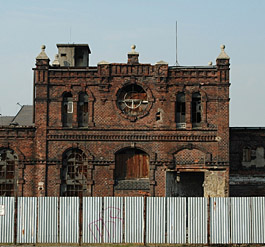
The leadership of Ostrava is negotiating with Bauhaus about the purchase of the historic slaughterhouse
 |
The dilapidated slaughterhouse, which is one of the most significant historical landmarks in Ostrava, was acquired by Bauhaus along with the land for its department store in the 1990s, but it has never been utilized. According to the agreement, the company was supposed to renovate the building, but that did not happen. Bauhaus defended itself by stating that nothing regarding the renovation was included in the contract. The company is now closing its store.
Hrabina said that the city received an offer to purchase the aforementioned properties. "The city will consider the options, and we will also consider various financing methods. We agreed to meet again in the near future to discuss this offer," said the deputy.
According to Kajnar, the Czech representative of Bauhaus, Aleš Pacal, did not rule out the possibility of splitting the entire complex and, if it would be advantageous for the company, selling the slaughterhouse separately from the store. "He (Pacal) said that if there were small price differences, he personally would prefer the city to acquire the slaughterhouse," said the mayor.
The purchase price for the entire property is expected to be around 100 million crowns. "But we did not discuss that, rather the upper limit of the estimate," Kajnar said. According to him, this limit is about 40 percent higher than 100 million.
The slaughterhouse is significant for Ostrava both historically and for the potential revitalization of the city center near Stodolní Street. "I believe the city council will realize this as well, and if the price is reasonable, we could buy it," said Kajnar.
It is more likely that the city would only buy the slaughterhouse. "The idea that the city would purchase the entire complex is, in my opinion, not very realistic, because the price will be multiple times higher for the entire area, and I cannot imagine what we would do with the store itself. But at least we committed to preliminarily explore whether there could be any possible use for the store for the city, and we will try to consider that," said the mayor.
The historically and architecturally valuable complex of municipal slaughterhouses made of natural bricks was built in 1881. The slaughterhouse operated until the 1970s, and in the 1990s, part of the building was demolished.
The English translation is powered by AI tool. Switch to Czech to view the original text source.
0 comments
add comment
Related articles
0
24.02.2024 | Relay for Bauhaus - happening at four stops
1
14.02.2024 | The Ostrava cultural public wants to preserve the spaces of the former hobby market
0
16.05.2022 | In Ostrava, you can see the renovated building of the former slaughterhouse
2
04.03.2022 | In Ostrava, the reconstruction of the historic building of the former slaughterhouse is nearing completion
2
21.01.2022 | Ostrava Gallery Plato is preparing to move to the renovated slaughterhouse facility
0
14.09.2021 | Ostrava will sell a complex of properties adjacent to the former slaughterhouse building
0
24.05.2018 | Ostrava will temporarily secure the roof of the former slaughterhouse
0
11.10.2017 | The city of Ostrava will negotiate with the Poles regarding the contract for the project of transforming the slaughterhouse
0
22.06.2017 | Ostrava will buy a complex of houses near the historic slaughterhouse
0
24.05.2017 | Ostrava will present competition proposals for the reconstruction of the slaughterhouse
0
02.05.2017 | The competition for the transformation of the Ostrava slaughterhouse was won by the studio Petr Hájek Architekti
0
23.03.2017 | The proposals for the transformation of the historical slaughterhouse will be known in Ostrava in April
0
25.01.2017 | The representatives of Ostrava approved the conditions for the competition to repair the slaughterhouse
0
18.12.2016 | Historical slaughterhouse in Ostrava awaits inspection by heritage conservationists
0
16.11.2016 | Ostrava will announce an architectural competition for the renovation of the slaughterhouse
0
31.08.2016 | Ostrava will take over the historic city slaughterhouse
0
15.06.2016 | Ostrava is likely to regain the former city slaughterhouse after years of effort
0
10.03.2010 | Ostrava is still striving for the city slaughterhouse designated as a cultural monument









